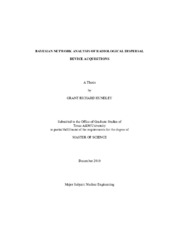| dc.description.abstract | It remains unlikely that a terrorist organization could produce or procure an actual nuclear weapon. However, the construction of a radiological dispersal device (RDD) from commercially produced radioactive sources and conventional explosives could inflict moderate human casualties and significant economic damage. The vast availability of radioactive sources and the nearly limitless methods of dispersing them demand an inclusive study of the acquisition pathways for an RDD. A complete network depicting the possible acquisition pathways for an RDD could be subjected to predictive modeling in order to determine the most likely pathway an adversary might take. In this work, a comprehensive network of RDD acquisition pathways was developed and analyzed utilizing the Bayesian network analysis software, Netica. The network includes variable inputs and motivations that can be adjusted to model different adversaries. Also, the inclusion of evidence nodes facilitates the integration of real-time intelligence with RDD plot predictions.
A sensitivity analysis was first performed to determine which nodes had the greatest impact on successful completion of RDD acquisition. These results detail which portions of the acquisition pathways are most vulnerable to law enforcement intervention. Next, a series of case studies was analyzed that modeled specific adversarial organizations. The analysis demonstrates various features of the constructed Bayesian RDD acquisition network and provides examples of how this tool can be utilized by intelligence analysts and law enforcement agencies. Finally, extreme cases were studied in which the adversary was given the maximum and minimum amount of resources in order to determine the limitations of this model.
The aggregated results show that successful RDD acquisition is mostly dependent on the adversary’s resources. Furthermore, the network suggests that securing radiological materials has the greatest effect on interdicting possible RDD plots. Limitations of this work include a heavy dependence on conditional probabilities that were derived from intuition, as opposed to actual historical data which does not exist. However, the model can be updated as attempted or successful RDD plots emerge in the future. This work presents the first probabilistic model of RDD acquisition pathways that integrates adversary motivations and resources with evidence of specific RDD threats. | en |


